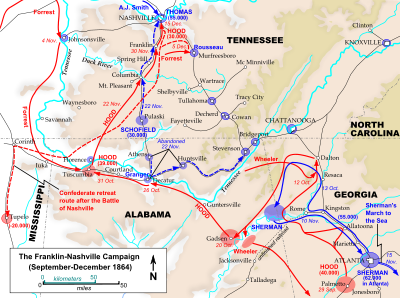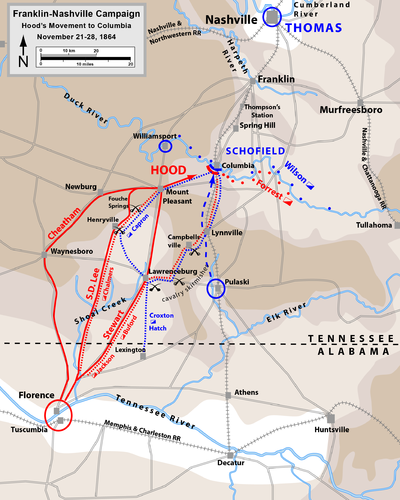Tuesday, December 2, 2014
Battle of Franklin
While Sherman's army was on its infamous march to the sea, the Confederate army under Hood which had been driven out of Atlanta was not idle. Hood led his men North, hoping to cut Sherman's supply line with the aid of Nathan Bedford Forrest's cavalry, forcing him to turn North to chase the Confederates. At first Sherman's movements were hampered by troops that he positioned to watch for Hood. But finally he decided to head off south, leaving the army of George Thomas to cope with Hood. Hood's hope was that by moving into Tennessee he would force Sherman to turn back from his march across Georgia to pursue him.
The Confederates marched quickly, trying to destroy separate Union corps before they could unite. On November 29th, Hood sent two corps to flank John Scofield's two infantry corps. The rebels were able to reach a position from which they had a great opportunity to strike the Yankees, but through mistakes of the Confederate command the attack was never made. That night Schofield moved 12 miles north to Franklin, Tennessee. The Confederates followed the next day, and found the Federals in an entrenched position. The aggressive John Bell Hood was determined to destroyed the Federals before they made it to the even stronger works of Nashville, so he ordered a frontal attack to be made that evening. Some of his generals expressed worry at the formidable works, but they were determined to capture them. As the famed Patrick Cleburne said, "[I]f we are to die, let us die like men."
On the evening of November 30, Hood's 20,000 men charged across two miles of open ground against the prepared Federal works. They first smashed two advance Federal brigades, and in the center of the line around the Carter House, they broke through the main line. Federals quickly counterattacked, and after hours of hand to hand fighting contained the Confederate foothold, and finally regained their lines. The Confederate attack was eventually beaten back all along the line. This charge has been called by many the Pickett's Charge of the West, but in many ways it far exceeded it. The gallant Confederates at Franklin were attacking earthworks. They suffered 6,000 casualties, many more than Pickett, including Cleburne and eleven other generals. Although the Federal army retreated the next day, the Confederate Army of the Tennessee was crushed.
Labels:
battle,
George Thomas,
John Bell Hood,
Tennesse






0 comments:
Post a Comment